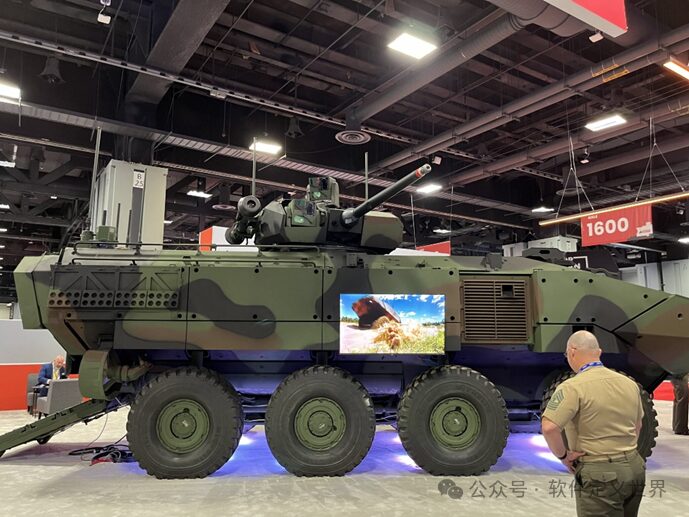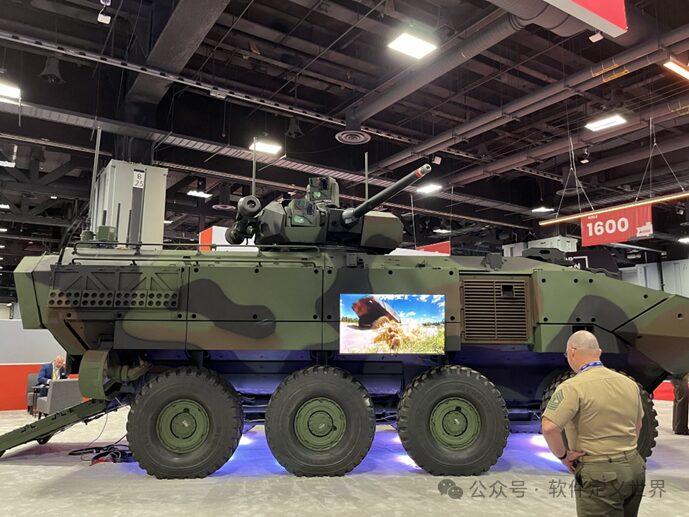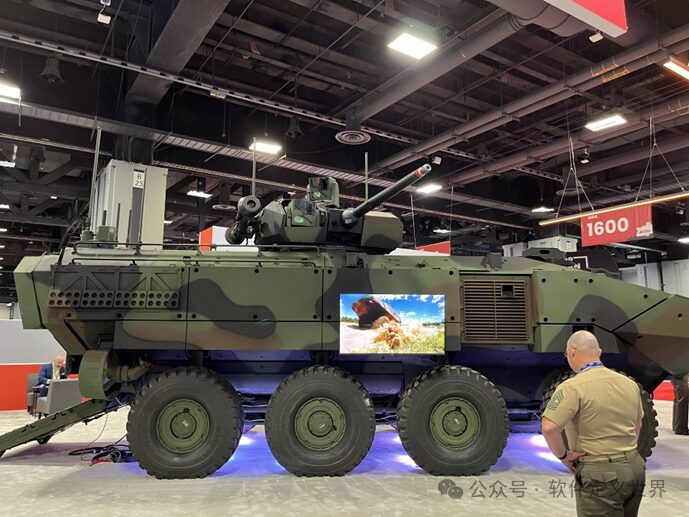
Software Defined World

On the turret of the ACV-30 amphibious combat vehicle, the Thales Catherine thermal imaging sensor can be seen, providing advanced threat detection and imaging capabilities for weapon stations and crew members.
-
Integrating thermal imagers, cameras, and acoustic detection systems onto vehicle platforms to enhance situational awareness for personnel in armored operations. -
Networked systems that enable data sharing and coordination within formations through powerful networking and interoperability standards like C5ISR/EW Modular Open Standards (CMOSS) and VICTORY. -
Power management through smart distribution and control systems to support increased sensor and processing loads, reduce signal features, and enable silent surveillance capabilities.
Sensors for Closed Hatch Operations
For vehicle survivability, the most critical types of sensors include infrared sensors for vision, acoustic sensors for shooting protection, and thermal imagers for targeting.
HD Minerva is Thales’s latest uncooled thermal imaging sensor, serving as the “external eyes” for Driver Vision Enhancement (DVE) and Local Situational Awareness (LSA), playing a crucial role when vehicle personnel conduct armored maneuvers.

Thales’s Minerva HD uncooled thermal imaging sensor serves as the “external eyes” for vehicle personnel operating under armor, with its 1280×1024 HD detector providing twice the pixel count of the previous VGA sensors.
Minerva is designed and manufactured by Thales at its global uncooled technology center in Canada, integrating uncooled long-wave infrared (LWIR) HD 1280×1024, 12-micron detectors—which is quite rare in uncooled devices—and a full HD 1920×1080 visible light module. Minerva’s sensor outputs full digital 60 Hz video (3G-SDI), with low latency and automatic image processing algorithms ensuring users can immediately optimize situational awareness without adjustments, experiencing zero-latency operation. This means users can rely on real-time images to provide the information needed for quick action, feel secure, and gain a crucial tactical advantage.
“The pixel count provided by our cameras is double that of previous sensors, and operators will immediately feel this difference compared to the equipment they have used in the past,” Balascik said. “You can see farther and clearer than standing outside the vehicle with your own eyes. It’s a completely different way of experiencing the surrounding world to understand what your vehicle and other vehicles in the formation are doing.”
(2) HD Minerva Acoustic Sensor
If the HD Minerva is the eyes of the enhanced Driver Vision Enhancement (DVE)/Local Situational Awareness (LSA) system, then the gunshot protection enabled by Thales’s Acusonic system is the ears. The Acusonic gunshot detection system overcomes inherent weaknesses of other shooting detection systems. It does not merely rely on capturing muzzle flash to provide accurate direction—which is a fatal flaw of other systems due to false positives—Acusonic also utilizes the supersonic shockwave and wake characteristics of projectiles to enhance the detection of muzzle flash, thereby providing detection and threat localization capabilities in complex battlefield environments.

Thales’s Acusonic system, launched for robotic applications, transforms the system into a multifunctional sensor by providing remote control capabilities for robotic vehicle operators.
“This is what sets us apart from previous systems,” Balascik noted, mentioning that Acusonic has been selected for the UK Army Ajax armored vehicle and Boxer mechanized infantry vehicle projects. “It is being tested on multiple prototypes in the U.S., and the reason we have gained such recognition is that the system does not continuously generate false positives. It is actually a force multiplier rather than a hindrance.” It has proven capable of providing accurate enemy fire point location information for special forces operating in coastal or riverine environments, where enemy fire points may be concealed.
The signals collected from Acusonic can also play a crucial role on ground robotic platforms (such as the XM30 mechanized infantry vehicle), providing what is known as “remote control” capability. Most robotic vehicles only offer visual perception, but those equipped with Acusonic allow operators to not only see what the robot sees but also hear the sounds it collects, thus gaining a better understanding of the surrounding environment.
(3) Thermal Imagers and Laser Rangefinders
The third category of key sensors for vehicle survivability is thermal imagers and laser rangefinders used for target localization. Thales has a wide product range for target localization, including a cooled thermal imager named SharpView, which has been integrated into the Marine Corps Air Defense Integrated System (MADIS) air defense vehicle, as well as a system called Panoramic Armored Overhead Gimbal (PAAG).
PAAG is a compact, stable 360-degree electronic monitoring and aiming system that provides multiple functions for vehicle commanders and personnel through a combination of sensors. These sensors include cooled thermal imagers and high-resolution daytime color cameras (both with continuous zoom capabilities), as well as laser rangefinders and laser target designators. Together, they provide personnel with day-and-night all-weather remote threat detection and identification, weapon aiming, and fire support capabilities. All operations can be remotely controlled from within the vehicle to ensure personnel are protected at all times.
“Whether for air defense systems like MADIS or new vehicles like the Marine Corps Advanced Reconnaissance Vehicle, our camera systems provide these vehicle personnel with next-generation thermal imagers,” Balascik said. “This is crucial because the military is upgrading to 30mm medium caliber weapon system turrets. This means you need thermal imagers with additional range to be able to see the same maximum effective range as the weapon system.”
Smart Power Management and Standards
Integrating these systems in space-constrained vehicles presents its unique challenges. For instance, the vehicle systems themselves need to possess certain intelligent functionalities, such as in-vehicle network management and especially energy management.
“Compared to vehicles from several years ago, our vehicles today can make more decisions, but they are still just a means of transportation from point A to B, and they have limited power to drive these vehicles and power the systems inside,” said Patrick Allison, TDSI Defense Business Development Director. “Without power, you cannot go to battle, which is absolutely essential, and how you manage power may determine whether your operational plan succeeds or fails.”
Thales offers a range of power management systems that not only distribute power but also deliver the right amount of power to various systems on the vehicle, which also helps reduce vehicle signature management. Power loads are intelligently managed, allowing operators to draw power from one area as needed and reserve it for others. This is particularly important during nighttime and covert operations, allowing personnel to keep systems running without starting the vehicle, enabling silent surveillance capabilities.
Compliance with standards like CMOSS and VICTORY is a key enabling technology that allows governments and original equipment manufacturers (OEMs) to integrate new functionalities into vehicles as threats and demands evolve. “In command, control, communications, computers, and intelligence (C4I), vehicles launched after 2030 will require compliance with CMOSS and CMFF standards,” Allison pointed out. “This will enable the Army to upgrade or add systems to these platforms based on open standards and architectures that allow systems to be interchangeable across different platforms. Thales is researching the C4I aspects of CMOSS and providing capabilities for voice and data transmission on the battlefield.”
(The content of the article is compiled from internet sources for the purpose of sharing and learning.)
Recap
Reinterpreting Operating Systems from a Software-Defined Perspective
The U.S. military continues to advance SCA ecosystem development in the post-SCA era
Jiefang Information awarded “Top Ten Leading Enterprises” & “Top Ten Leading Figures” titles
Software-defined radio boosts spectrum monitoring applications in U.S. military signal intelligence

Software Defined World
Get More Updates |Long press the QR code or click on the business card